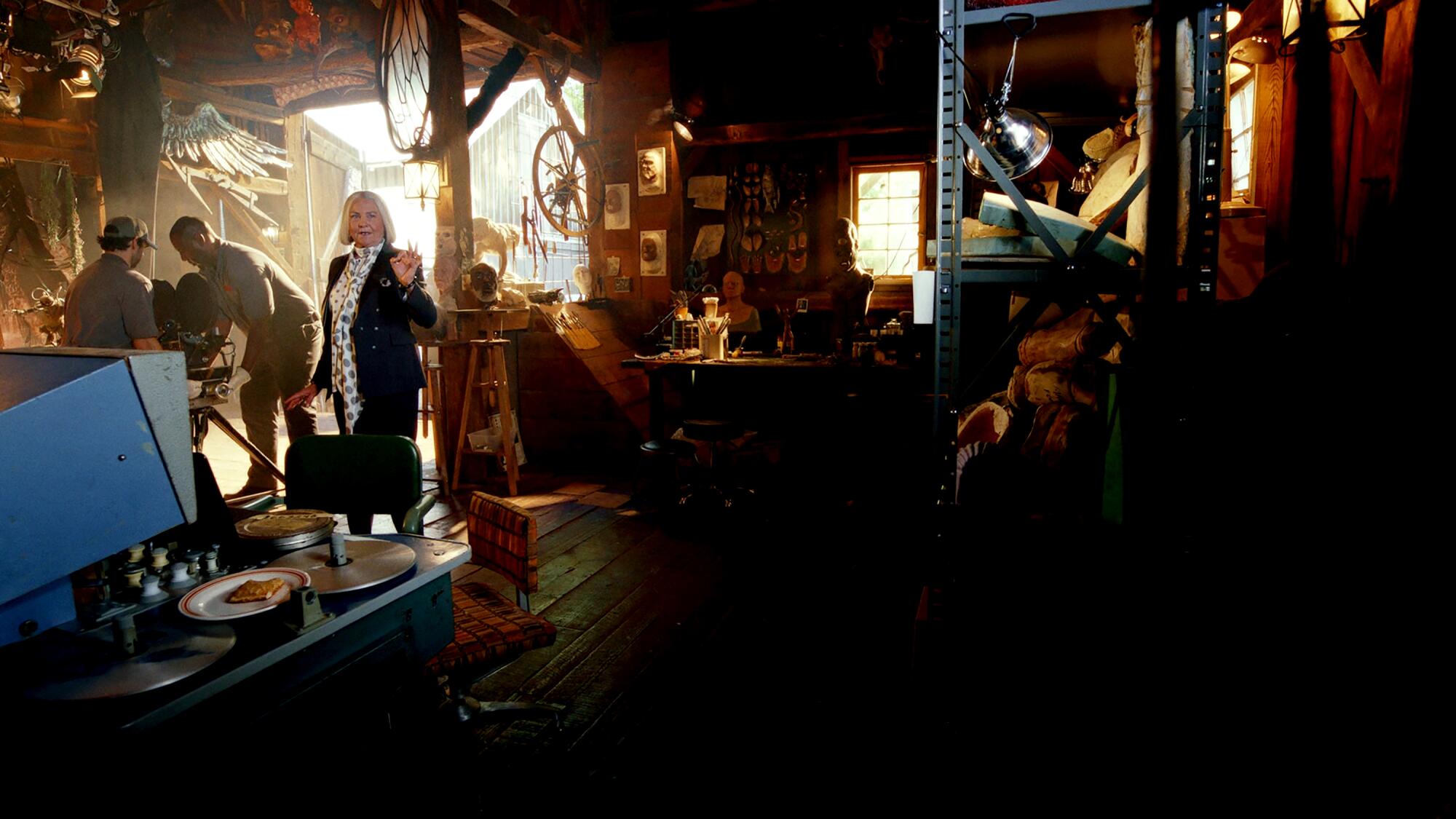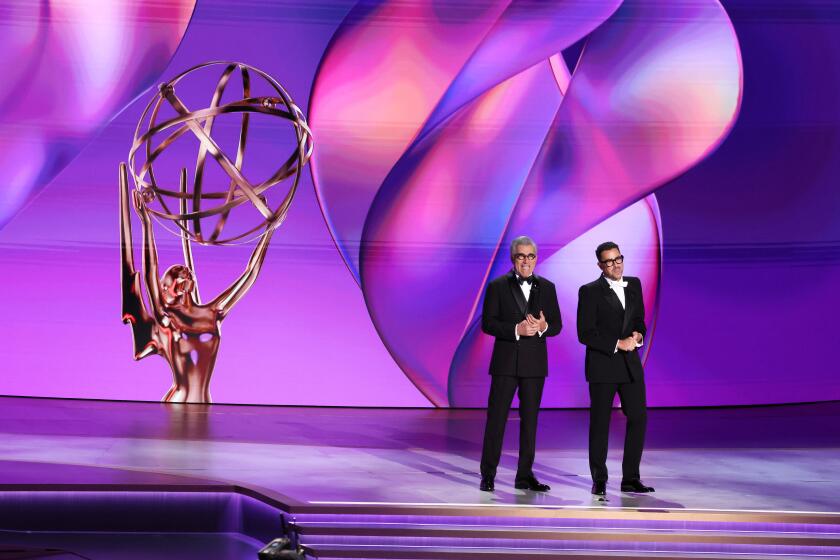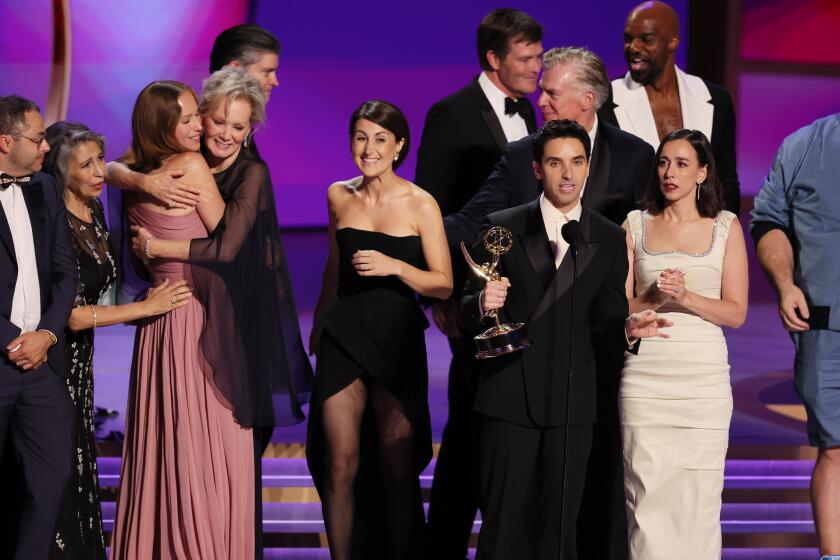
Ten episodes, 10 different looks, including a large barbecue, a sleazy casino and a dinner theater. Such was the challenge posed to production designer Judy Rhee when she signed on to work with Rian Johnson on his episodic Peacock series “Poker Face,” and she leaped in with both feet. Result? A first-ever Emmy nomination, for “The Orpheus Syndrome” episode, which is steeped in Hollywood below-the-line history and stars Nick Nolte and Cherry Jones.
It’s the kind of assignment Rhee was perfect for, with decades of working on such shows as “Jessica Jones” and “Better Call Saul” and the movie “Art House.” Rhee chatted with The Envelope on a recent Zoom call about making the modern look retro (and vice versa), why she bases herself on the East Coast — and doing excellent work that, ideally, goes ignored by audiences.
What’s it like to have a production designer’s eye? Are you always on alert for great locations, props or buildings?
I actually can’t turn it off. So much of my experience comes from a life lived, and having traveled. I’ve absorbed the things I encounter, and it gets in the library of things and comes out at the weirdest moments.

How did “Poker Face” creator Rian Johnson‘s brief read to you before you signed on?
He was inspired by the ‘70s mystery shows — like “Murder She Wrote” and “Columbo” and “The Rockford Files,” which was brilliant. My first assumption was that we would travel across the country for a lot of these shoots — but that was not the case. I had to create these different geographic locations in [New York’s] Hudson Valley, with a couple of exceptions. There were no standing sets, with 10 different stories, based on an episodic schedule: that is, every 10 days [we shot another episode]. There were a lot of plates spinning in the seven months we were working on it.
Created by Rian Johnson of ‘Knives Out’ acclaim, the mystery-thriller features the actor playing an amateur detective with a unique set of skills — and a striking lineup of guest stars.
The series has a retro feel, even though it takes place in the modern era. How did you create that look?
In a lot of the scripts, the way the characters are written implies they’re off the beaten path, tucked away in their own worlds. I liked having this open palette of it being timeless, because you have more to work with. Most people don’t upgrade and buy new things constantly. It’s all about finding visual prompts and cues as to who the characters are.
What made “The Orpheus Syndrome” the right episode to submit for Emmy consideration?
It was a difficult call. It was one of the most unique in terms of what we did with it. We used this I.M. Pei [designed] building [the former IBM Somers Office Complex in upstate New York], and how we augmented that was interesting on many levels. Trying to connect all the story points in such a huge space — it was so large, like a compound.… I didn’t set out to tell the location scout, “find something hard-edged,” but more “what would contrast Arthur’s [Nolte’s] barn,” which had natural wood and warmer colors.

Do you think on some level voters responded to the Hollywood historical basis for “Orpheus”?
Probably! That would be an added bonus. Nick Nolte was playing a character loosely based on [Emmy and Oscar-winning special effects expert] Phil Tippett, and what we did in that barn, on top of what Phil built, I thought really authentically worked to imagine this history of an artist — his 30 years of work.
You moved from L.A. to New York to study film back in the day. Why cross the country to get into the film biz?
A lot of the filmmakers who spoke to me at the time — Jim Jarmusch, [Martin] Scorsese — and a lot of the ‘70s films I loved took place in New York. I felt like this is where I needed to be, and I’ve been here ever since. It suits my personality.

Men dominate the production design field. Does an uneven gender balance affect dynamics behind the scenes when you’re heading up production design?
I never worked with a female production designer when I was art directing. Not to say they didn’t exist, but it was rare. There’s a lot more awareness and openness to genders in various positions now, but women have to prove themselves more than men do, in general. There’s a waiting period after I’m hired to see what it is I can do. It’s an odd compliment to have someone say, “You did such a great job!” as if they’re surprised. I mean, what did you think was going to happen?
What’s it like to develop a skill that — when you do it right — goes unnoticed by most people who see it?
That’s the double-edged sword for production design, because you want it to feel integrated. You don’t want to call attention to it, because then it’s a distraction to the story. My process is very intuitive, so it’s rare on a project to make a conscious choice to say, “This character needs to represent this color or style.”

If you win the Emmy, will you keep it in a custom-designed case in your beautifully designed home?
I think it would just get absorbed into my bookcase. I hadn’t thought about it, though now I will, since you’ve brought it to my attention. But my apartment is pretty cluttered and messy, because I travel a lot for work. It’s the cobbler’s kid situation. I live in New York City in a small 700-square-foot space — but it’s mine, and it’s home.
Our BuzzMeter panel of veteran TV journalists predicts the winners in 14 categories of the 2023(?) Emmys. You can, too, in our weekly polls.
More to Read
From the Oscars to the Emmys.
Get the Envelope newsletter for exclusive awards season coverage, behind-the-scenes stories from the Envelope podcast and columnist Glenn Whipp’s must-read analysis.
You may occasionally receive promotional content from the Los Angeles Times.









